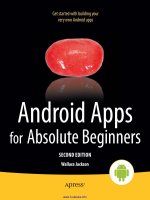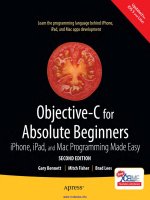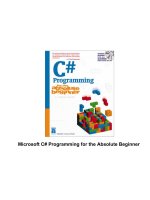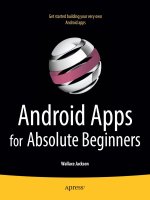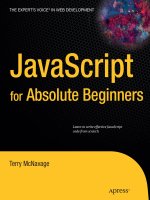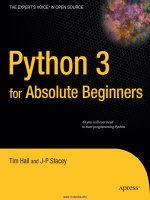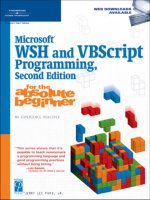Objective-C for Absolute Beginners docx
Bạn đang xem bản rút gọn của tài liệu. Xem và tải ngay bản đầy đủ của tài liệu tại đây (8.91 MB, 334 trang )
www.it-ebooks.info
For your convenience Apress has placed some of the front
matter material after the index. Please use the Bookmarks
and Contents at a Glance links to access them.
www.it-ebooks.info
iv
Contents at a Glance
Contents v
About the Authors x
About the Technical Reviewer xi
Acknowledgments xii
Introduction xiii
■Chapter 1: Becoming a Great iOS or Mac Programmer 1
■Chapter 2: Programming Basics 13
■Chapter 3: It’s All About the Data 39
■Chapter 4: Making Decisions About…and Planning Program Flow 63
■Chapter 5: Object Oriented Programming with Objective-C 87
■Chapter 6: Learning Objective-C and Xcode 103
■Chapter 7: Objective-C Classes, Objects, and Methods 129
■Chapter 8: Programming Basics in Objective-C 163
■Chapter 9: Comparing Data 199
■Chapter 10: Creating User Interfaces 215
■Chapter 11: Storing Information 237
■Chapter 12: Protocols and Delegates 261
■Chapter 13: Memory, Addresses, and Pointers 267
■Chapter 14: Introducing the Xcode Debugger 291
Index 309
www.it-ebooks.info
xiii
Introduction
Over the last three years, we’ve heard the following countless times:
■ “I’ve never programmed before, but I have a great idea for an iPhone/iPad app.”
■ “Can I really learn to program the iPhone or iPad?”
We always answer, “Yes, but you have to believe you can.” Only you are going to tell yourself
you can’t do it.
For the Newbie
This book assumes you may have never programmed before. The book is also written for
someone who may have never programmed before using object-oriented programming (OOP)
languages. There are many Objective-C books out there, but all of these books assume you have
programmed before and know OOP and computer logic. We wanted to write a book that takes
readers from knowing little or nothing about computer programming and logic to being able to
program in Objective-C. After all, Objective-C is the native programming language for the iPhone,
iPad, and Mac.
Over the last three years, we have taught well over a thousand students at xcelMe.com to be
iPhone/iPad (iOS) developers. Many of our students have developed some of the most successful
iOS apps in their category in the iTunes App Store. We have incorporated what we have learned
in our first two courses, Introduction to Object-oriented Programming and Logic and Objective-C
for iPhone/iPad Developers, into this book.
For the More Experienced
Many developers who programmed years ago or programmed in a non-OOP language need a
background in OOP and Logic before they dive into Objective-C. This book is for you. We gently
walk you through OOP and how it is used in iOS development to help make you a successful iOS
developer.
Why Alice: An Innovative 3D Programming Environment
Over the years, universities have struggled with several issues with their computer science
departments:
■
High male-to-female ratios
■
High drop-out rates
www.it-ebooks.info
■ INTRODUCTION
xiv
■ Longer than average time to graduation
One of the biggest challenges to learning OOP languages like Java, C++, or Objective-C is the steep learning
curve from the very beginning. In the past, students had to learn the following topics all at once:
■ Object-oriented principles
■ A complex Integrated Development Environment (IDE), i.e., Xcode, Eclipse, Visual
Studio
■ The syntax of the programming language
■ Programming logic and principles
As a result, Carnegie Mellon University received a grant from the US government and
developed Alice. Alice, an innovative 3D programming environment, makes it easy for new
developers to create rich graphical applications. Alice is a teaching tool for students learning to
program in an OOP environment. The software uses 3D graphics and a drag-and-drop interface
to facilitate a more engaging, less frustrating first programming experience.
Alice enables students to focus on learning the principles of OOP without having to focus on
learning a complex IDE and Objective-C principles all at once. You get to focus on each topic
individually. This helps students feel a real sense of accomplishment as they progress.
As drag-and-drop programming, Alice removes all the complexity of learning an IDE and
programming language syntax. You’ll see programming is actually fun, and you can develop very
cool and sophisticated apps in Alice.
After we introduce the OOP topic and readers feel comfortable with the material, we then
move into Xcode, where you get to use your new OOP knowledge in writing Objective-C
applications. This way, you can focus on the Objective-C syntax and language without having to
learn OOP at the same time.
Learning Objective-C Without Alice
More than a thousand xcelMe.com students have used this book to become successful iOS
developers. At the end of each course, we ask our students if the Alice sections in the first four
sections were useful. More than half of the students thought using Alice at the beginning of the
first four chapters to introduce the chapter was critical to their success. However, some of the
students didn’t feel they needed the Alice examples at the beginning of the first four chapters.
We have laid out the first four chapters of this book with the first part of each chapter
introducing the OOP topic with Alice; the remaining part of the chapter introduces the topic
using Objective-C. Thus, you can skip the Alice material if you feel comfortable with the topic.
How This Book Is Organized
You’ll notice that we are all about successes in this book. We introduce the OOP and Logic
concepts in Alice and then move those concepts to Xcode and Objective-C. Many students are
visual or learn by doing. We use both techniques. We’ll walk you through topics and concepts
with visual examples and then take you through step-by-step examples reinforcing the concepts.
We often repeat topics in different chapters to reinforce what you have learned and apply
these skills in new ways. This enables new programmers to reapply development skills and feel a
sense of accomplishment as they progress. Don’t worry if you feel you haven’t mastered a topic.
Keep moving forward!
www.it-ebooks.info
■ INTRODUCTION
xv
The Formula for Success
Learning to program is an interactive process between your program and you. Just like learning to play an
instrument, you have to practice. You must work through the examples and exercises in this book.
Understanding the concept doesn’t mean you know how to apply it and use it.
You will learn a lot from this book. You will learn a lot from working through the exercises in
this book. However, you will really learn when you debug your programs. Spending time walking
through your code and trying to find out why it is not working the way you want is an
unparalleled learning process. The downside of debugging is a new developer can find it
especially frustrating. If you have never wanted to throw your computer out the window, you will.
You will question why you are doing this, and whether you are smart enough to solve the
problem. Programming is very humbling, even for the most experienced developer.
Like a musician, the more you practice the better you get. By practicing, we mean
programming! You can do some amazing things as a programmer. The world is your oyster.
Seeing your app in the iTunes App Store is one of the most satisfying accomplishments. However,
there is a price, and that price is time spent coding and learning.
Having taught more than a thousand students to become iOS developers, we have put
together a formula for what makes students successful. Here is our formula for success:
■ Believe you can do it. You’ll be the only one who says you can’t do this. So don’t tell
yourself that.
■ Work through all the examples and exercises in this book.
■ Code, code, and keeping coding. The more you code, the better you’ll get.
■ Be patient with yourself. If you were fortunate enough to have been a 4.0 student who
can memorize material just by reading it, this will not happen with Objective-C
coding. You are going to have to spend time coding.
■ You learn by reading this book. You really learn by debugging your code.
■ Use the free xcelMe.com webinars and YouTube videos explained at the end of this
chapter.
■ Don’t give up!
The Development Technology Stack
We will walk you through the process of understanding the development process for your iOS apps and what
technology you need. However, briefly looking at all the pieces together is helpful. For a sample iPhone app in
a Table View, see Figure 1.
www.it-ebooks.info
■ INTRODUCTION
xvi
Figure 1. The iPhone/iPad technology stack
Required Software, Materials, and Equipment
One of the great things about Alice is it available on the three main operating systems used today:
■ Windows
■ Mac
■ Linux
The other great thing about Alice is it is free! You can download Alice at www.Alice.org.
Operating System and IDE
Although you can use Alice on many platforms, the Integrated Development Environment (IDE)
that developers use to develop iOS apps is Xcode. You have to use an Intel-based Mac to use Xcode
and submit apps! Xcode is free and is available in the Mac App Store.
www.it-ebooks.info
■ INTRODUCTION
xvii
Software Development Kits
You will need to register as an iOS developer. You can do this at
When you are ready to upload your app to the iTunes App Store, you will need to pay
$99/year.
Dual Monitors
We recommend developers have a second monitor connected to their computer. It is great to
step through your code and watch your output window and iPad simulator at the same time on
dual independent monitors. Apple hardware makes this easy. Just plug your second monitor into
the display port of any Intel-based Mac, with the correct Mini DisplayPort adapter of course, and
you have two monitors working independently of one another. See Figure 2. Note that dual
monitors are not required. You will just have to organize your open windows to fit on your screen
if you don’t.
Figure 2. Dual monitors
Free Live Webinars, Q&A, and YouTube Videos
Nearly every Wednesday night at 7:30 p.m. Pacific daylight time, we have live webinars and
discuss a topic from the book or a timely item of interest. These webinars are free, and you can
register for them at www.xcelme.com/free-webinars.php.
At the end of the webinars, we do a Q&A. You can ask a question on the topic discussed or
any topic in the book.
www.it-ebooks.info
■ INTRODUCTION
xviii
Additionally, all these webinars are recorded and available on YouTube.
Make sure you subscribe to the YouTube channel so you are notified when new recordings
are uploaded.
Figure 3. Free Objective-C webinars and YouTube videos
Free Book Forum
We have developed an online forum for this book at , where you can ask
questions while you are learning Objective-C and get answers from the authors. You will also find
answers to the exercises and additional exercises to help you learn. See Figure 3.
You can also access answers to exercises and discover helpful links to help you become a
successful iPhone/iPad developers and create great apps. See Figure 4. So let’s get started!
www.it-ebooks.info
■ INTRODUCTION
xix
Figure 4. Reader Forum for accessing answers to exercise and posting questions for authors
www.it-ebooks.info
1
Chapter
Becoming a Great iOS or
Mac Programmer
Now that you’re ready to become a software developer and have read the Introduction
of this book, you need to become familiar with several key concepts. Your computer
program will do exactly what you tell it to do—no more and no less. It will follow the
programming rules that were defined by the operating system and programming
language. Your program doesn’t care if you are having a bad day or how many times
you ask it to perform something. Often, what you think you’ve told your program to do
and what it actually does are two different things.
KEY TO SUCCESS: If you haven’t already, take a few minutes to read the Introduction of this
book. The Introduction shows you where to go to access the free webinars, forums, and YouTube
videos that go with each chapter. Also, you’ll better understand why we are using the Alice
programming environment and how to be successful in developing your iOS and Mac apps.
Depending on your background, working with something absolutely black and white
may be frustrating. Many times, programming students have lamented, “That’s not what
I wanted it to do!” As you begin to gain experience and confidence programming, you’ll
begin to think like a programmer. You will understand software design and logic, and
you will experience having your programs perform exactly as you want and the
satisfaction associated with this.
Thinking like a Developer
Software development involves writing a computer program and then having a computer
execute that program. A computer program is the set of instructions that we want the
computer to perform. Before beginning to write a computer program, it is helpful to list
the steps that we want our program to perform, in the order we want them
accomplished. This step-by-step process is called an algorithm.
1
www.it-ebooks.info
CHAPTER 1: Becoming a Great iOS or Mac Programmer
2
If we want to write a computer program to toast a piece of bread, we would first write an
algorithm. This algorithm might look something like this:
1. Take the bread out of the bag.
2. Place the bread in the toaster.
3. Press the toast button.
4. Wait for the toast to pop up.
5. Remove the toast from the toaster.
At first glance, this algorithm seems to solve our problem. However, our algorithm leaves
out many details and makes many assumptions. For example,
1. What kind of toast does the user want? Does the user want white bread,
wheat, or some other kind of bread?
2. How does the user want the bread toasted? Light or dark?
3. What does the user want on the bread after it is toasted: butter,
margarine, honey, or strawberry jam?
4. Does this algorithm work for all users in their cultures and languages?
Some cultures may have another word for toast or not know what toast is.
Now, you might be thinking we are getting too detailed for just making a simple toast
program. Over the years, software development has gained a reputation of taking too
long, costing too much, and not being what the user wants. This reputation came to be
because computer programmers often start writing their programs before they have
really thought through their algorithms.
The key ingredients to making successful applications are design requirements. Design
requirements can be very formal and detailed or as simple as a list on a piece of paper.
Design requirements are important because they help the developer flush out what the
application should do and not do when complete. Design requirements should not be
completed in a programmer’s vacuum, but should be produced as the result of
collaboration between developers, users, and customers.
www.it-ebooks.info
CHAPTER 1: Becoming a Great iOS or Mac Programmer
3
NOTE: If you take anything away from this chapter, take away the importance of considering
design requirements and user interface design before starting software development. This is the
most effective (and least expensive) use of time in the software development cycle. Using a
pencil and eraser is a lot easier and faster than making changes to code because you didn’t have
others look at the designs before starting to program.
Another key ingredient to your successful app is the user interface (UI) design. Apple
recommends that you spend over 50% of the entire development process focusing on
the UI design. The design can be simple pencil-and-paper layouts created using the
iPhone Application Sketch Book or the iPad Application Sketch Book by Dean Kaplan
(Apress, 2009) or on-screen layout created with the Omni Group’s OmniGraffle
(www.omnigroup.com) software application with the Ultimate iPhone Stencil plug-in
(www.graffletopia.com). Many software developers start with the UI design, and after
laying out all the screen elements and having many users look at paper mock-ups, they
then write out the design requirements from their screen layouts.
After you have done your best to flush out all the design requirements, laid out all the
user interface screens, and had the client(s) or potential customers look at your design
and give you feedback, coding can begin. Once coding begins, design requirements
and user interface screens can change, but the changes are typically minor and easily
accommodated by the development process. See Figures 1–1 and 1–2.
Figure 1–1 shows a mock-up of a mobile banking app screen prior to development
using OmniGraffle. Developing mock-up screens along with design requirements forces
developers to think through many of the applications usability issues before coding
begins. This enables the application development time to be shortened and makes for a
better user experience and better reviews on the iTunes App Store. Figure 1–2 shows
how the view for the mobile banking app actually appears when completed.
www.it-ebooks.info
CHAPTER 1: Becoming a Great iOS or Mac Programmer
4
Figure 1–1. This is a User Interface (UI) mock-up of the Account Balance screen for an iPhone mobile banking app
before development begins. This UI design mock-up was completed using OmniGraffle.
www.it-ebooks.info
CHAPTER 1: Becoming a Great iOS or Mac Programmer
5
Figure 1–2. This screenshot shows a completed iPhone mobile banking application as it appeared on the iTunes
App Store. This app is called Woodforest Mobile Banking.
Completing the Development Cycle
Now that we have our design requirements and user interface designs and have written
our program, what’s next? After programming, we need to make sure our program
matches the design requirements and user interface design and ensure that there are no
errors. In programming vernacular, errors are called bugs. Bugs are undesired results of
our programming and must be fixed before the app is released to the App Store. The
process of finding bugs in programs and making sure the program meets the design
requirements is called testing. Typically, someone who is experienced in software
testing methodology and who didn’t write the app performs this testing. Software testing
is commonly referred to as Quality Assurance (QA).
NOTE: When an application is ready to be submitted to the iTunes App Store, Xcode gives the file
an .app extension, for example, appName.app. That is why iPhone, iPad, and Mac applications
are called apps. We will use “program,” “application,” and “app” to mean the same thing
throughout this book.
During the testing phase, the developer will need to work with QA staff to determine why
the application is not working as designed. The process is called debugging. It requires
www.it-ebooks.info
CHAPTER 1: Becoming a Great iOS or Mac Programmer
6
the developer to step through the program to find out why the application is not working
as designed. Figure 1–3 shows the complete software development cycle.
Figure 1–3. The typical software development cycle
Frequently during testing and debugging, changes to the requirements (design) must
occur to make the application more usable for the customer. After the design
requirements and user interface changes are made, the process begins over again.
At some point, the application that everyone has been working so hard on must be
shipped to the iTunes App Store. Many considerations are taken into account when this
happens:
Cost of development
Budget
Stability of the application
Return on investment
There is always the give-and-take between developers and management. Developers
want the app perfect and management wants to start realizing revenue from the
investment as soon as possible. If the release date were left up to the developers, the
app would likely never ship to the App Store. Developers would continue to tweak the
app forever, making it faster, more efficient, and more usable. At some point, however,
the code needs to be pried from the developers’ hands and uploaded to the App Store
so it can do what it was meant to do.
Introducing Object Oriented Programming
As discussed in detail in the Introduction, Alice enables us to focus on object oriented
programming (OOP) without having to cover all the Objective-C programming syntax
and complex Xcode development environment in one big step. Instead, we can focus on
learning the basic principles of OOP and using those principles quickly to write our first
programs.
For decades, developers have been trying to figure out a better way to develop code
that is reusable, manageable, and easily maintained over the life of a project. OOP was
designed to help achieve code reuse and maintainability while reducing the cost of
software development.
www.it-ebooks.info
CHAPTER 1: Becoming a Great iOS or Mac Programmer
7
OOP can be viewed as a collection of objects in a program. Actions are performed on
these objects to accomplish the design requirements.
An object is anything that can be acted on. For example, an airplane, person, or
screen/view on the iPad can all be objects. We may want to act on the plane by making
the plane bank. We may want the person to walk or to change the color of the screen of
an app on the iPad. Actions are all being applied to these objects; see Figure 1–4.
Figure 1–4. These are two objects in an Alice application, a Dropship and Fighter. Both objects can have actions
applied—takeoff and landing, turn right and turn left
Alice will run a program, such as the one shown in Figure 1–4, for you if you click the
play button. When we run our Alice applications, the user can apply actions to the
objects in our application. Similarly, Xcode is an Integrated Development Environment
(IDE) that enables us to run our application from within our programming environment.
We can test our applications on our computers first before running them on our iOS
devices by running the apps in Xcode’s simulator, as shown in Figure 1–5.
www.it-ebooks.info
CHAPTER 1: Becoming a Great iOS or Mac Programmer
8
Figure 1–5. This sample iPhone app contains a table object to organize a list of courses. Actions such as “rotate
left” or “user did select row 3” can be applied to this object.
Actions that are performed on objects are called methods. Methods manipulate objects
to accomplish what we want our app to do. For example, for our jet object in Figure 1–4,
we might have the following methods:
goUp
goDown
bankLeft
turnOnAfterBurners
lowerLandingGear
Our table object in Figure 1–5 is actually called UITableView when we use it in a
program, and it could have the following methods:
loadView
shouldAutorotateToInterfaceOrientation
numberOfSectionsInTableView
cellForRowAtIndexPath
didSelectRowAtIndexPath
www.it-ebooks.info
CHAPTER 1: Becoming a Great iOS or Mac Programmer
9
All objects have data that describes those objects. This data is defined as properties.
Each property describes the associated object in a specific way. For example, the jet
object’s properties might be as follows:
altitude = 10,000 feet
heading = North
speed = 500 knots
pitch = 10 degrees
yaw = 20 degrees
latitude = 33.575776
longitude = -111.875766
For our UITableView object in Figure 1–5, the following might be our properties:
backGroundColor = Red
selectedRow = 3
animateView = No
An object’s properties can be changed at any time when our program is running, when
the user interacts with the app, or when the programmer designs the app to accomplish
the design requirements. The values stored in the properties of an object at a specific
time are collectively called the state of an object.
State is an important concept in computer programming. When teaching students about
state, we ask them to go over to a window and find an airplane in the sky. We then ask
them to snap their fingers and make up some of the values that the plane’s properties
might have at that specific time. Those values might be
altitude = 10,000 feet
latitude = 33.575776
longitude = -111.875766
Those values represent the state of the object at the specific time that they snapped
their fingers.
After waiting a couple minutes, we ask the students to find that same plane, snap their
fingers again, and record the plane’s possible state at that specific point in time.
The values of the properties might then be something like
altitude = 10,500 feet
latitude = 33.575665
longitude = -111.875777
Notice how the state of the object changes over time.
Working with the Alice Interface
Alice offers a great approach in using the concepts that we have just discussed without
all the complexity of learning Xcode and the Objective-C language at the same time. It
takes only a few minutes to familiarize oneself with the Alice interface and begin writing
a program.
The Introduction of this book describes how to download Alice. After it’s downloaded
and installed, you need to open Alice. It will look like Figure 1–6.
www.it-ebooks.info
CHAPTER 1: Becoming a Great iOS or Mac Programmer
10
Figure 1–6. Alice IDE running
Technically speaking, Alice is not a true IDE like Xcode, but it is pretty close and much
easier to learn than Xcode. A true IDE combines code development, user interface
layout, debugging tools, documentation, and simulator/console launching for a single
application; see Figure 1–7. However, Alice offers a similar look, feel, and features to
Xcode. This will serve you well later when we start writing Objective-C code.
www.it-ebooks.info
CHAPTER 1: Becoming a Great iOS or Mac Programmer
11
Figure 1–7. The Xcode integrated development environment (IDE) with the iPhone Simulator
In the next chapter, you will go through the Alice interface and write your first program.
Summary
Congratulations, you have finished the first chapter of this book. It is important that you
have an understanding of the following terms because they will be reinforced throughout
this book:
Computer program
Algorithm
Design requirements
User interface
Bug
Quality assurance (QA)
Debugging
Object oriented programming (OOP)
www.it-ebooks.info
CHAPTER 1: Becoming a Great iOS or Mac Programmer
12
Object
Property
Method
State of an object
Integrated development environment (IDE)
Exercises
Answer the following questions:
Why is it so important to spend time on your user requirements?
What is the difference between design requirements and an
algorithm?
What is the difference between a method and a property?
What is a bug?
What is state?
Write an algorithm for how a soda machine works from the time a coin
is inserted until a soda is dispensed. Assume the price of a soda is 80
cents.
Write the design requirements for an app that will run the soda
machine.
www.it-ebooks.info
13
Chapter
Programming Basics
This chapter will focus on the building blocks that are necessary to become a great
Objective-C programmer. This chapter is going to go over how to use the Alice user
interface, how to write our first Alice program, how to write our first Objective-C
program, and explore some new OOP terms.
NOTE: We want to introduce new concepts in Alice and later, in this chapter, enable you to use
these concepts in Objective-C. We have used this approach for the last 3 years and know, from
personal experience, that this approach helps you learn the concepts quickly, without
discouragement, and gives you a great foundation to build upon.
Taking a Tour with Alice
Alice’s 3D programming environment makes it easy to write your first program, as it
applies some of the principles that you have learned in Chapter 1. First, you need to
learn a little more about Alice’s user interface. When we first launch Alice, we are
presented with a screen that looks like Figure 2–1.
You can start with the default blue sky and green grass template or pick another
template with a different background. Feel free to explore and have fun. This is where
we will spend most of our time and write our first Alice application.
The Alice user interface is set up to help us efficiently write our applications. The user
interface is very similar in form and function to the Xcode IDE. We will now explore the
major sections of Alice.
2
www.it-ebooks.info
CHAPTER 2: Programming Basics
14
Figure 2–1. Opening screen in Alice
Navigation Menu
The Navigation menu, shown in Figure 2–2, enables us to open and close files, set our
application preferences, and view world statistics, text output, and the error console. We
can also access example worlds and Alice Help from the Navigation menu.
NOTE: It is important that you save your program frequently when using Alice. If Alice crashes
and you haven’t saved your work, you will lose all your code or changes since you last saved.
Additionally, we recommend that you close Alice completely and reopen it when you want to
open a new Alice program.
www.it-ebooks.info
CHAPTER 2: Programming Basics
15
Figure 2–2. This shows the Alice’s user interface’s main sections Take some time to explore the user interface.
You will see in this chapter how it compares with Xcode and how it will help us learn Objective-C.
World Window
The World window shows what our virtual world will look like when it runs. This window
is similar to the iPhone/iPad simulator that we will use later to run our apps. The World
window enables us to take advantage of Alice’s 3D user interface to model our
application.
In the World window, we can move the camera around and place it where we want for
the viewing prospective we desire. Moving the three arrow tools in Figure 2–3 enables
incredible flexibility for bringing our applications to life.
It is important to learn how to move the camera around your world in order to get the
view you want the users to see.
www.it-ebooks.info
